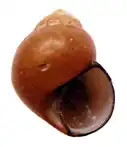Bithynia funiculata
| Bithynia funiculata | |
|---|---|

| |
| Apertural view of the shell of Bithynia funiculata | |
| Scientific classification | |
| Kingdom: | Animalia |
| Phylum: | Mollusca |
| Class: | Gastropoda |
| Subclass: | Caenogastropoda |
| Order: | Littorinimorpha |
| Superfamily: | Truncatelloidea |
| Family: | Bithyniidae |
| Genus: | Bithynia |
| Species: | B. funiculata
|
| Binomial name | |
| Bithynia funiculata Walker, 1927
| |
| Synonyms[1] | |
| |
Bithynia funiculata is a species of freshwater snail with a gill and an operculum, an aquatic gastropod mollusk in the family Bithyniidae.
Taxonomy
Previously (for example WHO 1995)[2] considered this taxon to be a subspecies of Bithynia siamensis, however, Bithynia funiculata is treated as a separate species in the 2012 IUCN Red List.[1]
Distribution
Distribution of this species includes:
Ecology
Bithynia funiculata is an intermediate host for:
- The cat liver fluke Opisthorchis tenuicollis[1]
- This species transfers echinostomiasis.[1]
- Some references also mention also the trematode Opisthorchis viverrini as a first intermediate host.[2]
References
- ^ a b c d e f Richter, K.; Simonis, J. (2012). "Bithynia funiculata". IUCN Red List of Threatened Species. 2012: e.T184937A1767230. doi:10.2305/IUCN.UK.2012-1.RLTS.T184937A1767230.en. Retrieved 18 November 2021.
- ^ a b World Health Organization (1995). Control of Foodborne Trematode Infection. WHO Technical Report Series. 849. PDF part 1, PDF part 2. page 125.
